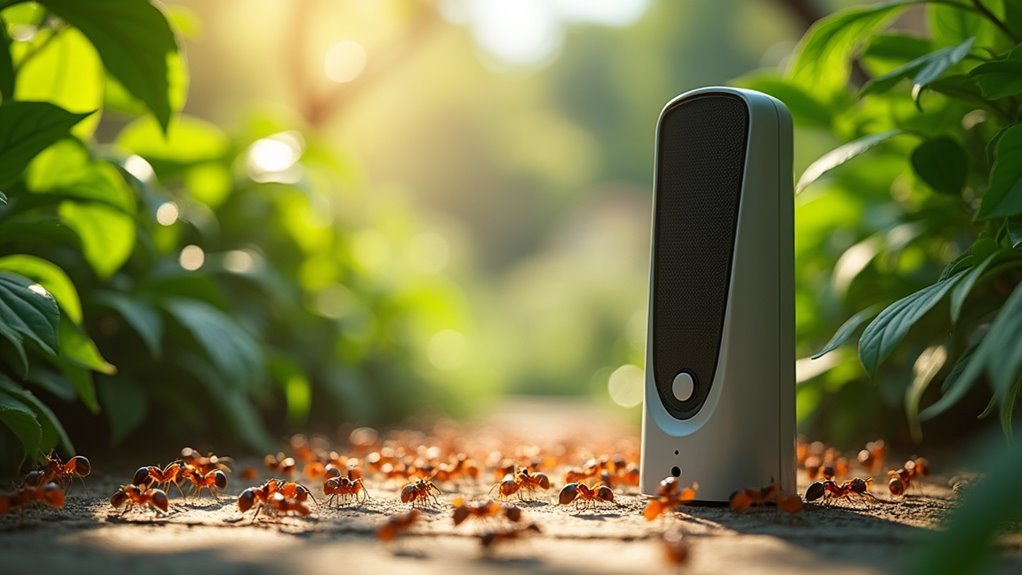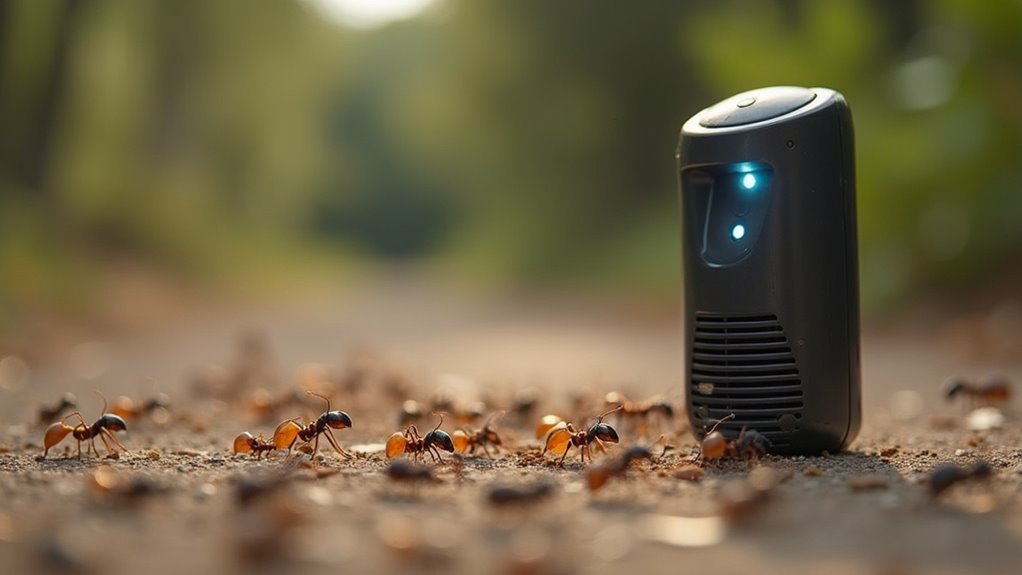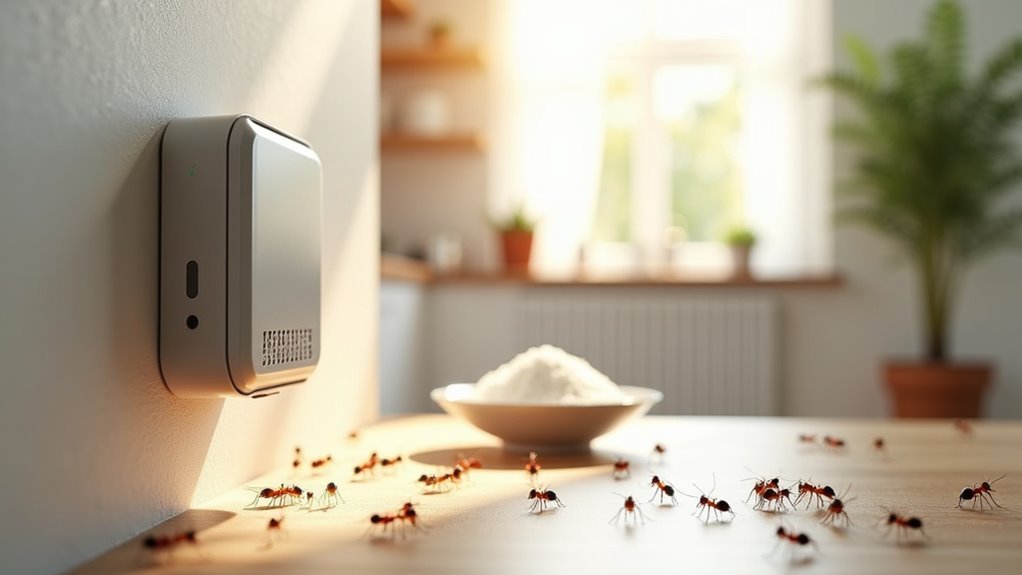You can effectively combat ant invasions using ultrasonic repellers that emit high-frequency sound waves above 20 kHz to disrupt their communication networks. These devices create an acoustically hostile environment that interferes with pheromone trail following, prevents colony establishment through constant sonic pressure, and targets ant sensory systems to block food source location. They’re chemical-free solutions perfect for sensitive indoor environments. Discover how proper placement and timing maximize their pest-fighting potential.
High-Frequency Sound Waves Disrupt Ant Communication Patterns

When you’re dealing with an ant invasion, ultrasonic repellers promise a high-tech solution by emitting sound waves above 20 kHz that target these insects’ communication systems.
These high-frequency sound waves create an inaudible sonic barrier that disrupts how ants share information about food sources and navigation routes. You’ll find that the constant bombardment interferes with their chemical trail communication, causing disorientation and confusion within the colony.
However, you should understand that ant communication proves remarkably adaptable.
Ant colonies demonstrate impressive resilience, quickly adapting their communication methods when faced with ultrasonic interference from repelling devices.
While these devices may create temporary aversion initially, ants often develop resistance to the ultrasonic interference. The effectiveness diminishes as colonies adjust their behavioral patterns, making the repellers less reliable over extended periods.
Your success depends largely on immediate implementation rather than long-term ant control.
Creating an Acoustically Hostile Environment for Foraging Ants
When you activate an ultrasonic repeller, you’re fundamentally bombarding your space with constant high-frequency sound waves that create an uncomfortable acoustic environment specifically targeting foraging ants.
These devices generate a relentless barrage of ultrasonic frequencies above 20 kHz that disrupts the ants’ ability to communicate effectively with their colony members.
You’ll find that this acoustic interference makes it difficult for ants to coordinate their foraging activities and navigate successfully through the treated area.
High-Frequency Sound Waves
Although ultrasonic pest repellers emit sound waves ranging from 20,000 Hz to over 65,000 Hz that remain inaudible to human ears, they’re specifically engineered to create an acoustically hostile environment for ants and other unwanted pests.
These high-frequency sound waves disrupt ant communication patterns and interfere with their natural foraging behaviors, making it challenging for them to locate food sources in your home.
When you position ultrasonic pest repellers strategically, the devices initially disorient ants through constant sound bombardment, forcing them to avoid treated areas.
However, you’ll need to understand that proper placement remains vital for effective pest control, as high-frequency waves travel limited distances and walls or furniture can absorb them.
Additionally, these devices may lose effectiveness over time as ants adapt, requiring you to combine them with other methods to successfully control pests long-term.
Disrupting Ant Communication
Ultrasonic repellers target the foundation of ant colonies by disrupting the sophisticated communication networks these insects depend on for survival.
These devices emit high-frequency sound waves above 20 kHz that interfere with the chemical signals ants use for foraging and navigation. You’ll find that this constant acoustic bombardment creates confusion among worker ants, making it difficult for them to locate food sources effectively.
The ultrasonic frequencies generate an acoustically hostile environment that causes physiological distress in these pests. Since ants rely heavily on pheromone trails for communication, disrupting these essential signals severely impacts their foraging efficiency and nesting behavior.
However, you should know that some ant species may develop tolerance to these sounds over time, potentially reducing long-term effectiveness of your ultrasonic repeller system.
Interference With Ant Navigation and Trail Following Behavior

You’ll find that ultrasonic repellers target ants’ sophisticated navigation systems by interfering with their ability to detect and follow chemical pheromone trails.
When these high-frequency sound waves disrupt the ants’ sensory reception, they can’t effectively pick up the scent markers that guide them along established foraging routes.
This interference fundamentally blocks the communication network that ants depend on to coordinate their collective movement and food-gathering activities.
Disrupting Chemical Pheromone Trails
Since ants rely heavily on chemical pheromone trails to navigate between their nests and food sources, any disruption to these invisible highways can severely impact their foraging efficiency.
Ultrasonic repellers target this vulnerability by emitting high-frequency sound waves that interfere with ants’ ability to detect these vital chemical signals. When you deploy these devices, they’re designed to scramble the pheromone communication system that keeps ant colonies organized and coordinated.
This disruption creates confusion within the colony, as worker ants can’t follow their established pathways to food sources or communicate locations effectively.
You’ll potentially notice ants becoming disoriented and abandoning their typical foraging behavior. While some users report reduced ant activity through disrupting chemical pheromone trails, scientific evidence supporting ultrasonic repellers’ effectiveness against ant navigation remains limited and requires further research.
Blocking Navigation Signal Systems
Beyond scrambling pheromone detection, ultrasonic repellers create broader interference with ants’ entire navigation framework by bombarding their sensory systems with disruptive high-frequency waves.
When you deploy an ultrasonic pest repeller, it generates constant acoustic pressure that makes communication nearly impossible between colony members. These high-pitched sound frequencies above 20 kHz create an acoustically hostile environment, forcing ants to abandon their established foraging routes and food sources.
The devices effectively block navigation signals that ants rely on for coordinated movement and trail-following behavior. This acoustic disruption addresses pest problems by making your property inhospitable to ant colonies.
However, you’ll need to take into account that ants may eventually adapt to persistent sound stimuli, potentially reducing long-term effectiveness.
Deterring Colony Establishment Through Constant Sonic Pressure
When ultrasonic repellers emit their high-frequency sound waves, they create an acoustically hostile environment designed to prevent ants from establishing colonies in your space. These Ultrasonic Pest Repellents continuously bombard areas with high-pitched frequencies, disrupting ant communication and foraging patterns essential for colony establishment.
| Exposure Duration | Effectiveness Level | Ant Response |
|---|---|---|
| First 24 hours | High | Active avoidance |
| 1-2 weeks | Moderate | Reduced activity |
| 3-4 weeks | Declining | Partial adaptation |
| 1-2 months | Low | Desensitization |
| Long-term | Minimal | Normal behavior |
The constant sonic pressure makes it difficult for pest scouts to locate suitable nesting sites and communicate findings to their colonies. However, ants may gradually adapt to these sound waves over time, reducing the repeller’s long-term effectiveness against colony establishment.
Targeting Ant Sensory Systems With Ultrasonic Frequencies

Ants rely heavily on their sophisticated sensory systems to navigate, communicate, and coordinate colony activities, making these biological mechanisms prime targets for ultrasonic interference.
When you deploy ultrasonic repellers, you’re directing high-frequency sound waves above 20 kHz directly at ants’ auditory systems. These ultrasonic sounds create discomfort and disorientation, disrupting their ability to follow pheromone trails and communicate effectively with colony members.
You’ll find that targeting these sensory pathways can trigger immediate avoidance behavior in these common household pests. The frequencies interfere with their foraging patterns and nesting decisions, forcing them to seek alternative routes or locations.
However, you should understand that this approach to pest issues requires strategic placement since sound waves travel short distances. For ideal control, you’ll need to position devices where ants typically enter your home.
Preventing Food Source Location Through Audio Disruption
Since foraging success depends on ants’ ability to establish and maintain clear communication pathways to food sources, ultrasonic repellers create an acoustically hostile environment that can considerably disrupt these essential activities. The high-frequency sound waves above 20 kHz interfere with ants’ communication systems, making it difficult for them to coordinate food discovery and relay location information to colony members.
| Disruption Method | Impact on Ant Behavior |
|---|---|
| Communication interference | Blocks pheromone trail coordination |
| Sound frequency bombardment | Causes disorientation during foraging |
| Route disruption | Prevents consistent pathways to food |
| Sensory overload | Creates physiological distress |
When pests are attracted to your dry cat food, these devices can effective repel them by scrambling their ability to maintain organized foraging patterns, though adaptation may occur over time.
Chemical-Free Pest Management for Sensitive Indoor Environments
Millions of households face the challenge of managing ant invasions while maintaining safe environments for children, pets, and family members with chemical sensitivities.
Ultrasonic pest management devices offer you a chemical-free solution that eliminates the risks associated with toxic sprays and baits. These environmentally friendly alternatives plug directly into standard electrical outlets and operate silently while targeting ants with high-frequency sound waves.
Consider the peace of mind you’ll gain with ultrasonic repellers:
- No poisoning risks for curious toddlers who explore every corner
- Zero toxic residues on surfaces where pets eat and sleep
- Elimination of harsh chemical odors that trigger respiratory sensitivities
- Continuous protection without dangerous bait stations throughout your home
- Safe operation around food preparation areas and children’s playrooms
Frequently Asked Questions
Do Ultrasonic Pest Repellers Work Against Ants?
Ultrasonic pest repellers don’t work reliably against ants. You might see temporary results, but ants typically become desensitized to the high-frequency sounds quickly. You’ll need professional pest control methods for effective, long-term ant management.
What Is the Best Deterrent for Ants?
You’ll find professional pest control treatments combined with prevention strategies work best. Keep surfaces clean, seal food in airtight containers, and eliminate entry points for thorough ant management that’s more reliable than ultrasonic devices.
Is There a Frequency That Repels Ants?
You won’t find a reliable frequency that repels ants. While ultrasonic devices claim frequencies between 20,000-65,000 Hz work, scientific studies show ants don’t respond effectively and quickly adapt to constant sounds.
What Are the Disadvantages of Ultrasonic Pest Repellers?
You’ll find ultrasonic pest repellers often lack scientific backing, have limited range, and pets may experience stress from the frequencies. Ants quickly adapt to the sounds, making these devices ineffective over time.
In Summary
You’ll find ultrasonic repellers offer a thorough, chemical-free solution for ant control. They’ll disrupt communication, navigation, and foraging while creating an uncomfortable environment that discourages colony establishment. You’re targeting their sensory systems directly, making it harder for them to locate food sources. If you’re dealing with sensitive indoor spaces where traditional pesticides aren’t suitable, these devices provide continuous protection without exposing your family to harmful chemicals.





Leave a Reply